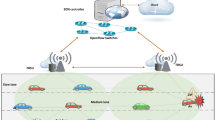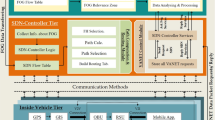Abstract
Recently, internet of vehicles (IoVs) is captivating a lot of interest due to a wide range of applications in various domains. These applications rely on up-to-date information of vehicles for provisioning various services. However, frequent message transmissions by a sheer number of vehicles may not only engulf a centralized server but may also cause a severe congestion which is not suitable for ongoing services specially in emergency situations. The aim of this study is to reduce congestion and messaging overhead. This paper presents a fog-assisted congestion avoidance scheme for IoV named energy efficient message dissemination (E2MD). Unlike most of the existing schemes, E2MD capitalizes the merits of fog computing to minimize communication cost and manage services. Each vehicle is required to update their status to a fog server frequently, either directly or through intermediate nodes. In case of an emergency, the fog server will timely inform upcoming traffic to slow down, dispatch rescue teams to provide necessary services, and coordinate patrolling missions to clear the road. Moreover, failure detection and recovery mechanisms are also presented to ensure availability of the fog server. The performance of the proposed scheme is validated through NS 2.35 simulations. Simulation results confirm the performance reign of E2MD compared to contemporary schemes in terms of latency and communication cost.











Similar content being viewed by others
References
Ahmad IN (2017) Characterizing the role of vehicular cloud computing in road traffic management. Int J Distrib Sens Netw 13(5):1–14
Ahmed EA (2017) Bringing computation closer toward the user network: is edge computing the solution? IEEE Commun Mag 55:138–144
Bihari B, Dubey N, Chauhan P, Kumar (2010) A survey on data dissemination techniques used in VANETs. Int J Comput Appl 10(7):5–10
Chang B-J, Liang Y-H, Huang Y-D (2015) Adaptive message forwarding for avoiding broadcast storm and guaranteeing delay in active safe driving VANET. Wirel Netw 21(3):739–756
Chang B-J, Liang Y-H, Huang Y-D (2016) Efficient emergency forwarding to prevent message broadcasting storm in mobile society via vehicle-to-X communications for 5G LTE-V. In: International computer symposium (ICS), Chiayi, Taiwan, pp 479–484
Chaqfeh M, Lakas A, Jawhar I (2014) A survey on data dissemination in vehicular ad hoc networks. Veh Commun 1(1):214–225
Chiang M, Zhang T (2016) Fog and IoT: an overview of research opportunities. IEEE Internet Things J 3(6):1–11
Chuang M-C, Chang Chen M (2013) DEEP: density-aware emergency message extension protocol for VANETs. IEEE Access 5(10):3504–3512
Dandala TT, Krishnamurthy V, Alwan R (2017) Internet of vehicles (IoV) for traffic management. In: International conference on computer, communication and signal processing (ICCCSP), Chennai, India, pp 1–15
Djahel S, Ghamri-Doudane Y (2012) A robust congestion control scheme for fast and reliable dissemination of safety messages in VANETs. In: IEEE wireless communications and networking conference: mobile and wireless networks, France, pp 2264–2269
Editors E (2016). Radar sensing for driverless vehicles. (Digi-Key). https://www.digikey.com/en/articles/techzone/2016/nov/radar-sensing-for-driverless-vehicles. Accessed 24 Nov 2018
Fangchun Y, Shangguang W, Jinglin L, Zhihan L, Qibo S (2014) An overview of internet of vehicles. China Commun 11(10):1–15
Gianfranco EM, Veniero M, Trombetta A, Sacco M, Clemente S (2018) Semantic based events signaling for AAL systems. J Ambient Intell Humaniz Comput 9:1311–1325
Gupta BB, Yamaguchi DP (2018) Deep learning models for human centered computing in fog and mobile edge networks. J Ambient Intell Humaniz Comput. https://doi.org/10.1007/s12652-018-0919-8
Gutiérrez-Reina D, Sharma V, You I, Toral S (2018) Dissimilarity metric based on local neighboring information and genetic programming for data dissemination in vehicular ad hoc networks (VANETs). Sensors 18(7):1–18
Hassan N, Gillani S, Ahmed E, Yaqoob I, Imran M (2018) The role of edge computing in internet of things. IEEE Commun Mag 56(11):110–115
Hou X, Li Y, Wu D, Jin D, Chen S (JUNE 2016) Vehicular fog computing: a viewpoint of vehicles as the infrastructures. IEEE Trans Veh Technol 65(6):3860–3873
Julio A, Sanguesa M, Fogue P, Garrido F, Martinez J, Cano CT (2016) A survey and comparative study of broadcast warning message dissemination schemes for VANETs. Mob Inf Syst 2016:1–19
Kang H, Yoo H, Kim D, Chung Y-s (2017) CANCORE: Context-Aware Network COded REpetition for VANETs. IEEE Access 5:1–9
Khabazian M, Aissa S, Mehmet-Ali M (2011) Performance modeling of message dissemination in vehicular ad hoc networks with priority. IEEE J Sel Areas Commun 29(1):61–71
Kukreja P, Sharma D (2016) A detail review on cloud, fog and dew computing. Int J Sci Eng Technol Res (IJSETR) 5(5):1–9
Kumar R, Dave M (2013) A framework for handling local broadcast storm using probabilistic data aggregation in VANET. Wirel Pers Commun 72(1):315–341
Li M, Zeng K, Lou W (2011) Opportunistic broadcast of event-driven warning messages in vehicular ad hoc networks with lossy links. Comput Netw 55:2443–2464
Lin D, Tang Y, Labeau F, Yao Y, Imran M, Athanasios V, Vasilakos (2017) Internet of vehicles for e-health applications: a potential game for optimal network capacity. IEEE Syst J 11(3):1888–1896
Merino R, Vaquero LM (2014) Finding your way in the fog: towards a comprehensive defininition of fog computing. SIGCOMM Comput Commun Rev 44(5):27–32
Munir B, Asif M, Wagan A, Hasbullah H (2010) Efficient congestion control in VANET for safety messaging. In: Information technology symposium (ITSim), vol 2, pp 654–659
Munir A, Laskar MTR, Sakhawat M (2018) A localized fault tolerant load balancing algorithm for RFID systems. J Ambient Intell Humaniz Comput 2018(1):1–13
Panichpapiboon S, Pattara-atikom W (2012) A review of information dissemination protocols for vehicular ad hoc networks. IEEE Commun Surv Tutor 14(3):784–798
Park S, Yoo Y (2017) Network intelligence based on network state information for connected vehicles utilizing fog computing. Mobile Information Systems, Cairo, pp 1–9
Paul A, Daniel A, Ahmad A, Rho S (2015) Cooperative cognitive intelligence for internet of vehicles. IEEE Syst J 11(3):1–10
Roma P, Gayatri J (2016) Traffic congestion detection and management using VANET. Int J Adv Res Innov Ideas Educ 2(3):1274–1280
Sattar S, Qureshi KH, Saleem M, Mumtaz S, Rodriguez J (2018) Reliability and energy-efficiency analysis of safety message broadcast in VANETs. Comput Commun 119:118–126
Schwarz S, Rup M (2016) Society in motion: challenges for LTE and beyond mobile communications. IEEE Commun Mag 54(5):76–83
Sharma V, Lim JD, Kim JN, You I (2017) SACA: self-aware communication architecture for IoT using mobile fog servers. Mob Inf Syst 2017:1–17
Shumayla Y, Ullah A, Akbar M, Imran M, Guizani (2018) Fog-assisted congestion avoidance scheme for internet of vehicles. In: International wireless communication and mobile computing (IWCMC). IEEE, Cyprus, pp 618–622
Sindhu G, Mittal P (2016) A novel model based on group controlled observation for DDOS attack detection and prevention in VANET. Indian J Sci Technol 9(36):1–6
Sushama WP, Choudhary S (2017) Data dissemination in software defined vehicular ad hoc network: a review. Int Res J Eng Technol (IRJET) 4(1):1–4
Syed A-H, Muddesar I, Atif S, Imran R, Hassan R (2017) An efficient channel access scheme for vehicular ad hoc networks. Hindawi Mob Inf Syst 2017:1–11
Ucar S, Ergen S, Coleri, Ozkasap O (2016) Multihop-cluster-based IEEE 802.11p and LTE hybrid architecture for VANET safety message dissemination. IEEE Trans Veh Technol 65(4):2621–2636
Ullah A, Yaqoob S, Imran M, Ning H (2019) Emergency message dissemination schemes based on congestion avoidance in VANET and vehicular FoG computing. IEEE Access 7:1570–1585
Wan J, Liu J, Shao Z, Vasilakos A, Imran M, Zhou K (2016) Mobile crowd sensing for traffic prediction in internet of vehicles. IEEE Sens 16(1):1–15
Xia S, Cheng X, Yang L, Zhang R, Jiao B (2014) Data dissemination in VANETs: a scheduling approach. IEEE Trans Intell Transp Syst 15(5):2213–2223
Xiaomin M, Gabe K, Kishor ST (2017) Application-level scheme to enhance VANET event-driven multi-hop safety-related services. In: Workshop on computing, networking and communications (CNC), Durham, pp 860–864
Xu W, Zhou H, Cheng N, Lyu F, Shi W, Chen J, Shen X (2018) Internet of vehicles in big data era. J Autom Sin 5(1):19–35
Yang X, Liu L, Jie, Vaidya NH, Zhao F (2004) A vehicle-to-vehicle communication protocol for cooperative collision warning. In: International conference on mobile and ubiquitous systems: networking and services, Boston, pp 114–123
Yaqoob IA (2016) Mobile ad hoc cloud: a survey. Wirel Commun Mob Comput 16(16):2572–2589
Yi S, Li C, Li Q (2015) A survey of fog computing: concepts, applications and issues. In: ACM proceedings of the 2015 workshop on mobile big data, Hangzhou, pp 37–42
Yusof DM, Abu-Bakar K (2011) A review of congestion control algorithm for event-driven safety messages in vehicular networks. Int J Comput Sci Issues 8(5):49–53
Zrar GK, Lloret J, Abu-Bakar K, Sadiq AS, Ben A, Mussa S (2013) Beaconing approaches in vehicular ad hoc networks: a survey. Wirel Pers Commun 73(3):885–912
Acknowledgements
This work is partially supported by the Deanship of Scientific Research, King Saud University through research group project number RG-1439-036.
Author information
Authors and Affiliations
Corresponding author
Additional information
Publisher’s Note
Springer Nature remains neutral with regard to jurisdictional claims in published maps and institutional affiliations.
Rights and permissions
About this article
Cite this article
Yaqoob, S., Ullah, A., Akbar, M. et al. Congestion avoidance through fog computing in internet of vehicles. J Ambient Intell Human Comput 10, 3863–3877 (2019). https://doi.org/10.1007/s12652-019-01253-x
Received:
Accepted:
Published:
Issue Date:
DOI: https://doi.org/10.1007/s12652-019-01253-x




